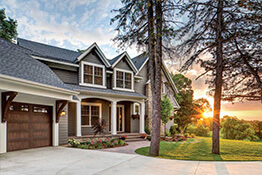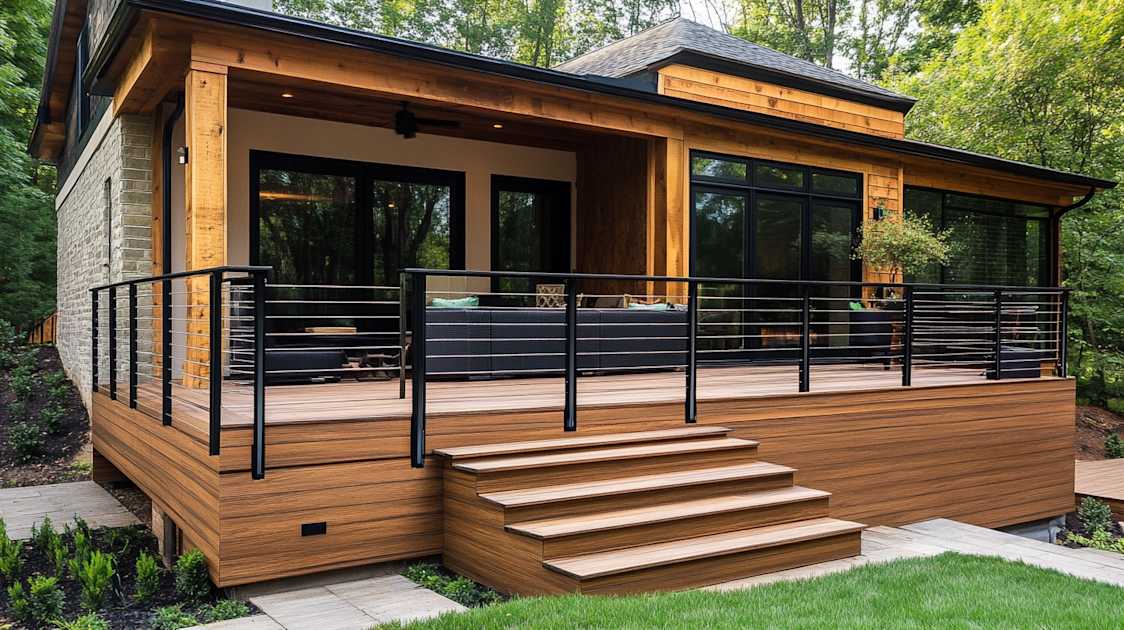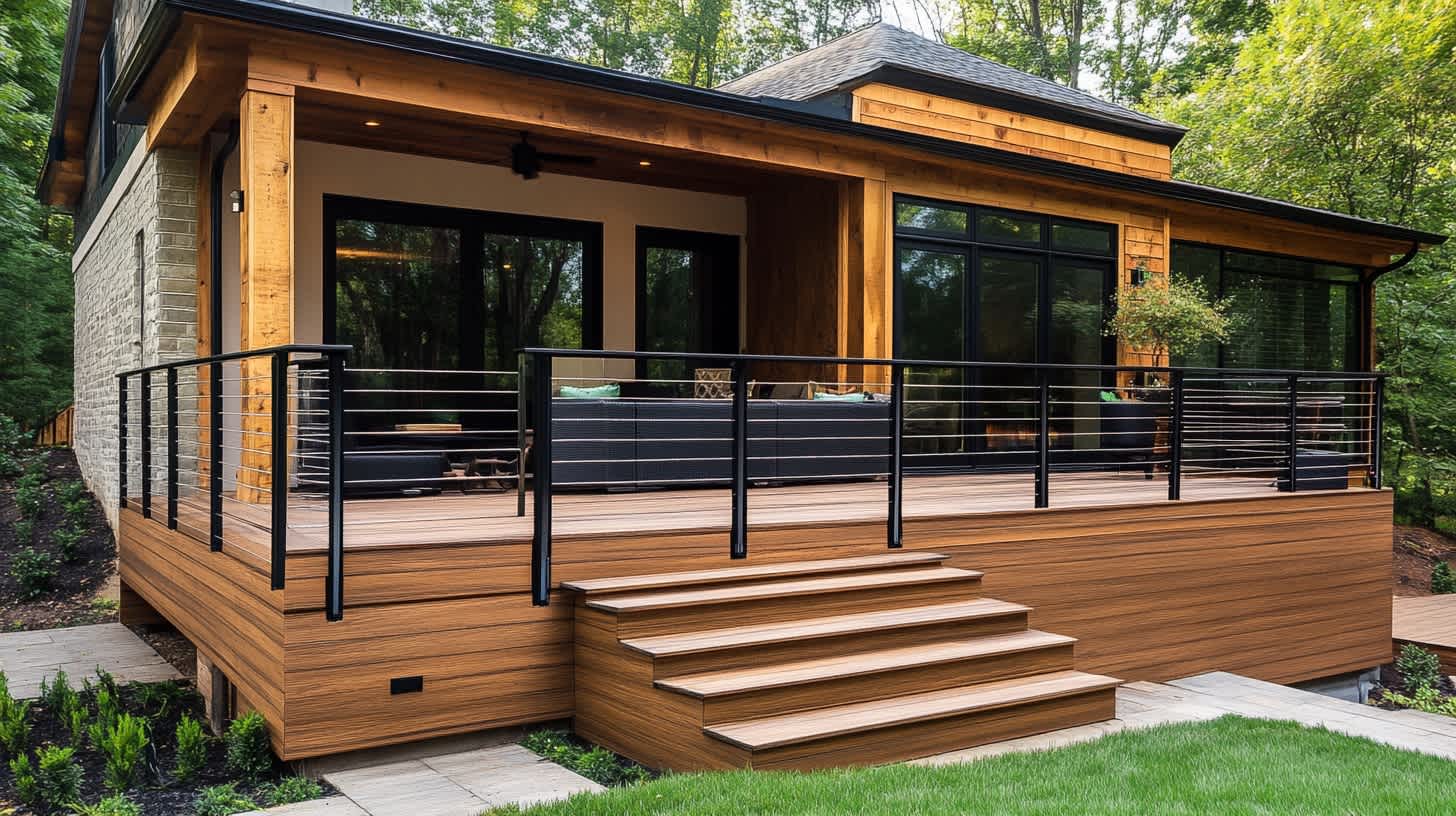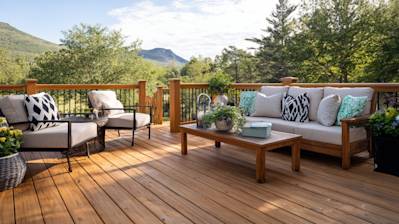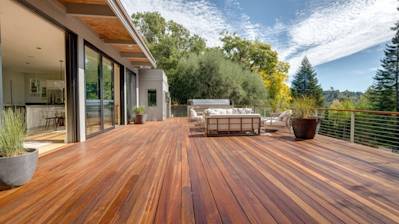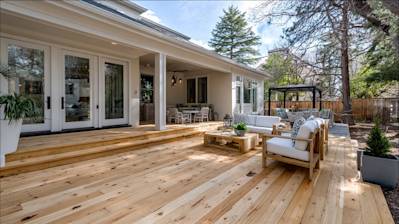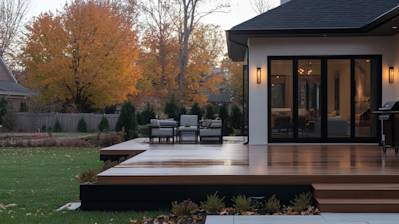Deck skirting serves multi-faceted purposes, from providing a finished look for your outdoor decks to a protective shield shielding the underside from pests and weather elements. Not only does it prove vital for your decks' structural integrity, but it also boosts your property's aesthetic appeal dramatically.
Let us go deep into the realm of deck skirting, discussing what it is, its importance, various options available, materials used, the process of installation, and maintenance.
What is Deck Skirting?
Deck skirting is the material installed around a deck's base, concealing the structure beneath and creating a more cohesive and finished appearance. It hides the joists and posts that are a necessary but not particularly attractive part of the deck's construction. Think of it as the ultimate MVP (Most Valuable Player) of your outdoor spaces — it works behind-the-scenes to make sure everything else looks great.
The Importance of Deck Skirting
Deck skirting does more than just visual service. Here's how:
- Protective Barrier - First, deck skirting forms a barrier, protecting the underside of the deck from pests like rats, raccoons, and possums, and invading weeds.
- Weather Guard - It also protects against inclement weather elements. Your deck boards and joists would last much longer with the shield of deck skirting.
- Extra Storage Space - In many cases, deck skirting can also create an enclosed area under the deck that can be utilized as a storage space for seasonal items.
Various Deck Skirting Options
When it comes to deck skirting, you have a plethora of options to choose from, including:
- Lattice Deck Skirting - It offers a timeless, traditional look while also allowing good airflow which can help keep the underside of the deck dry.
- Solid Board Skirting - Solid board skirting offers a more modern look and can be painted to match your deck or home.
- Raised Panel Skirting - Gives your deck a more polished and elegant look.
- Faux Stone Skirting - Its low maintenance and can endure harsher weather conditions for a longer time.
Materials Used for Deck Skirting
Deck skirting materials should be durable and have visual appeal. Some popular materials include:
- Wood - A classic choice. It's versatile and offers a wide range of customization options. However, wood might require frequent maintenance.
- Vinyl - A modern choice. It's cost-effective and doesn't demand much in terms of maintenance.
- Composite - This stands somewhere between wood and vinyl in terms of aesthetics and durability.
Process of Installing Deck Skirting
First, always make sure to measure your deck perimeter accurately. Here's a typical process:
- Choose the Material and Skirting Style - Based on your needs, choose a material best suited for your application and select a style that complements your space.
- Make Necessary Preparations - Remove any objects or debris from around the deck.
- Cut the Material - Cut your skirting material in accordance to your deck's measurement. If you're using a design like lattice, ensure the pattern aligns between panels.
- Install the Material - Attach the skirting to your deck. This usually involves screwing the skirting into the deck’s joists or framework.
- Paint or Stain - Finally, paint or stain the skirting to match your deck or home.
Frequently Asked Questions about Deck Skirting
What is the purpose of deck skirting?
Primarily, deck skirting is used for aesthetic purposes. It adds personality and a finished look to your deck. But aside from the aesthetics, deck skirting also provides a functional purpose such as preventing pests like raccoons, skunks, possums, and rats from nesting under your deck. It also hides unsightly deck underpinnings and serves as a barrier against harsh elements.
How can I measure my deck for skirting?
Start by measuring the distance from the deck floor to the ground. This will be the height of your deck skirting. Afterward, measure the perimeter of your deck. If your deck is not a perfect rectangle or square, it's best to measure each side separately. These measurements will give you the amount of material you'll need.
Do I need ventilation for my deck skirting?
Yes, ventilation is important in deck skirting. It prevents the buildup of moisture that could lead to mold, mildew and rot under your deck. This can be achieved by incorporating a lattice design, or by installing vents if you prefer a solid skirting material.
How can I install deck skirting?
The installation process varies depending on the material and style you choose for your deck skirting. Some can be manually nailed or screwed onto the deck while others such as vinyl or PVC composite materials might need special tools. If you're not confident in tackling this as a DIY project, consider hiring a professional to do it.
How do I maintain my deck skirting?
The type of maintenance your deck skirting needs depends on the material used. For wooden deck skirting, regular sealing, staining or painting is recommended to prevent it from rotting or warping. Vinyl or composite materials usually require no more than a good clean with mild soap and water.
Can I replace deck skirting after installation?
Absolutely. If your deck skirting becomes damaged or you simply want a new look, it can be replaced. However, it may require some effort and time depending on the type of material used.
How do I choose the best deck skirting for my home?
The best deck skirting for your home depends on your personal preferences, budget, and the climate of your location. Consider the design and color of your house, your deck, and your landscaping. It's advised to choose a material that is durable and able to withstand the elements in your area.
Can I incorporate lights into my deck skirting?
Yes, adding lighting to your deck skirting can enhance the aesthetic appeal while also adding an element of safety. You can integrate low voltage LED lights or solar-powered lights.
PROS of Deck Skirting
Aesthetically Pleasing
Among the most significant benefits of deck skirting is its potential to enhance your property's appearance. Skirting can complete the look of your deck, giving it a polished, finished aesthetic, and can also be tailored to match your home's existing style. A variety of materials are available, including wood, composite, vinyl, and metal, each offering its unique visual appeal.
Conceals Understructure
Deck skirting is perfect for hiding the unsightly understructure of your deck. It essentially acts like a curtain, keeping the unattractive spots like joists, posts, and beams out of sight. If you are using the area beneath your deck for storage, deck skirting helps keep it hidden from view, creating a more orderly and cleaner look to your outdoor living area.
Enhances Ventilation
Deck skirting is instrumental in ensuring good ventilation under your deck. A well-ventilated deck is crucial in preventing the build-up of moisture, which can result in wood rot and damage. Design techniques such as slat spacing or lattice patterns can provide this much-needed breathability.
Deters Pests
Well-installed deck skirting can help deter unwelcome animals, such as rabbits, raccoons, and rodents, from creating nests or burrows under your deck. The skirting acts as a barrier and can keep your deck – and your home – safer from unwanted pests.
Adds Value
Effective deck skirting can add value to your home. It enhances curb appeal by finishing off your deck and hiding any unsightly underlying structure. If you ever decide to sell your home, potential buyers will appreciate this detail.
CONS of Deck Skirting
Added Cost
Deck skirting, while it adds aesthetic appeal and functionality, is an additional expenditure to your budget. Depending upon the size of your deck, the materials used, and the complexity of the design, the cost can add up. Installing wooden or composite skirting tends to be more expensive than other materials like vinyl or lattice.
Maintenance and Upkeep
Depending on the skirting material, there may be considerable maintenance involved. Skirting made from wood will require regular paint or staining, cleaning, and periodic sealing to prevent rot or insect damage. Skirting materials such as vinyl or metal may be lower maintenance but still require regular cleaning.
May Restrict Access
The installation of deck skirting could potentially restrict access to the underneath of your deck. This could be problematic if you need to reach the under-deck for maintenance, pest control, or to utilize under-deck storage. You would have to incorporate access panels into your design, which could increase cost and complexity of installation.
Installations Can Be Complex
Installing deck skirting may not be a simple task, especially if you're planning to do it yourself. You need to consider factors like supporting the skirting, size and number of ventilation gaps, ensuring proper drainage, and providing access points. The skill and time required may necessitate hiring a professional, adding to your costs.
Weather and Environment Considerations
Depending on your geographical location, the materials you select for your skirting may face weather-related challenges. For example, in areas with a lot of moisture or extreme temperatures, wood skirting can warp, rot, or crack. On the other hand, metal skirting may heat up excessively in direct sunlight.
Limitations to Material Choices
Certain types of deck skirting may not be suitable for specific designs or environments. For instance, lattice skirting may not offer the same level of protection against pests as solid skirting would. On the other hand, skirting materials like stone could be unsuitable for decks built high off the ground due to weight and installation difficulty. This may limit your material choices, depending on your specific circumstances and requirements.
Summary
Alright, so deck skirting can really take your outdoor living space to a whole new level. Not only does it hide the unsightly view of the space beneath your deck, but it also adds a touch of style and elegance to your deck. With a wide variety of materials and designs to choose from, you can easily customize it to suit your personal taste and complement your home's architecture. So, deck skirting is not just functional, it's also a great way to showcase your aesthetic sense.
Why stop at just decking when deck skirting can significantly enhance the overall appearance of your yard? If you've got critters making a mess under your deck, it can act as a barrier and keep your deck space clean and tidy. Plus, it can help protect the understructure of your deck from the elements, which can save you time and money on maintenance in the long run. So, it's not just about looks, deck skirting offers plenty of practical benefits too.
Finally, let's talk a bit about installation. While the process of attaching deck skirting seems intimidating, it's totally doable if you're handy with tools. However, if you want more complex designs or are unsure about your DIY skills, it might be best to call a professional. Either way, with the right care and maintenance, your deck skirting can last for years to come. So, ultimately, it's a worthwhile and rewarding investment for your home.
About US Quality Construction of Columbus
Meet US Quality Construction of Columbus! Based in the heart of Columbus, OH, we're a team of skilled experts who never hesitate to roll up our sleeves and deliver top-notch construction services. For years, we've been a part of this community, bringing innovative construction solutions and delivering unmatched quality on each project we handle. From small residential renovations to large commercial builds, our portfolio is as diverse as our beloved city. We've built our reputation on integrity, reliability, and superior craftsmanship, and we look forward to showing you how we turn your construction dreams into reality. You can trust that with US Quality Construction of Columbus, every detail matters.
Tags: outdoor design, home improvement, deck renovation,
